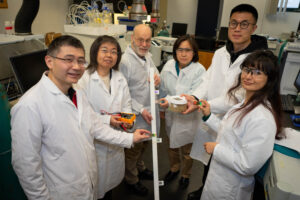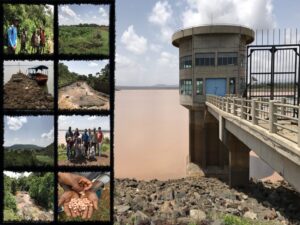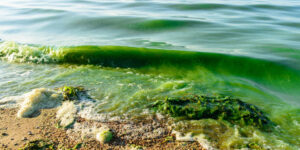
- Structural Engineering and Applied Mechanics
- Transportation and Urban Engineering
- Environmental Engineering
- Connecticut Manufacturing Simulation Center
- Connecticut Transportation Institute
- National Institute for Undersea Vehicle Technology
- Technical Assistance for Brownfields Program
- UConn Eversource Energy Center
Environmental Engineering
The water resources and environmental engineering group performs multidisciplinary research in the areas of surface and groundwater hydrology, land-atmosphere interactions, hydrometeorology, contaminant transport and remediation in aquatic and soil environments, watershed biogeochemistry, solar and microbial fuel cell energy production. The faculty interacts with a broader group of faculty members that are affiliated with the Environmental Engineering Program and also works closely with the Center for Environmental Science and Engineering.
Featured Projects
Collaborative Research: SitS NSF UKRI: Decoding Nitrogen Dynamics in Soil through Novel Integration of in-situ Wireless Soil Sensors with Numerical Modeling

Sponsor: National Science Foundation
Principal Investigator: Guiling Wang, Yu Lei, Karl Guillard, MD Shaad Mahmud (University of New Hampshire)
Period: 01/01/2020 - 12/31/2023
Budget: $800,000
Project Abstract
Excess nitrogen leaching from agricultural and horticultural lands into waterways is a long-standing challenge for agricultural sustainability and environmental protection. An effective approach to improve the water/fertilizer use efficiency is through precision farming practices guided by real-time monitoring and near-term forecast of crop irrigation and fertilization needs.
By targeting two critical soil signals: nitrogen species (ammonium and nitrate) and soil moisture, this US-UK SitS collaborative project will develop innovative hydrogel-coating solid-state ion-selective membrane (HS-ISM) soil nitrogen sensors, numerical models of rhizosphere nitrogen cycle through both lab-scale and field tests. This project will, for the first time, achieve high-resolution in-situ nitrogen profiling and predict the rhizosphere nitrogen dynamics under different weather and farming practices.
Water and Food Security PIRE
Sponsor: National Science Foundation
Principal Investigator: Prof. Emmanouil Anagnostou
Period: 01/01/2016 - 12/31/2022
Project Abstract
How do relationships between scientists, farmers, water managers, and authorities influence the production, dissemination, and outcome of new scientific knowledge? This project establishes an international research and education partnership to promote a political-institutional model of science that links sociological and engineering methods in a people-centered approach to the human-climate-water-agriculture-energy nexus in the Blue Nile basin (BNB), Ethiopia.
The project is a multi-year collaborative endeavor that will run from 2016 to 2021. By the end of the project, the research team will have crafted state-of-the-art tools to help smallholder farmers make practical decisions about water, crops, and fertilizers and ultimately gain more secure access to food and water in the face of increasingly challenging climatic extremes.
Coproducing Actionable Science to Understand, Mitigate, and Adapt to Cyanobacterial Harmful Algal Blooms (CHABS)
Sponsor: National Science Foundation
Principal Investigator: Christine Kirchhoff
Period: 01/01/2022 - 12/31/2025
Budget: $1,599,997
Project Abstract
Despite large investments in improving water quality efforts worldwide, cyanobacterial harmful algal blooms (CHABS) remain common and are getting worse. CHABs can produce toxins, which can sicken or kill humans and animals, impair recreational opportunities, and threaten the supply of drinking and irrigation water for millions of people worldwide. Improving water quality and reducing CHABs is vital for society and a healthy environment. Fundamental gaps in knowledge of this complex socio-environmental system (SES) limit our ability to fully understand the problem, assess response actions, and motivate and support transformative change. This DISES award supports research addressing critical knowledge gaps around the role of nutrient pollution in determining the size and toxin concentrations of CHABs, the promotion of farmer collective action, the economic benefits of water quality improvements, and improving SES governance. The investigators will address these gaps through improved watershed simulation and integrated economic and hydrologic modeling, advances in SES science and theory for water quality governance, and improved capacity for transforming SES through actionable knowledge to support CHABs decision making. Results will inform national integrated assessment models of nutrient pollution, and the guidance produced will inform management in other eutrophic waterbodies impacted by agriculture. This research will train the next generation of interdisciplinary SES scholars and practitioners including two postdoctoral scientists and seven graduate and at least eight undergraduate students. The team will involve more than 100 students in outreach. Multiple datasets will be made available on the Open Science Framework, and these will also be used to develop CHABs SES curricula that will benefit teachers and students in grades 5-12. The curricula will be distributed through the Teaching Channel and the daVinci Program.
CHABS degrade water quality and diminish essential ecosystem services worldwide. Despite longstanding efforts to understand this complex SES and reduce excess nitrogen and phosphorus inputs, poor water quality remains a persistent problem. Fundamental gaps in knowledge of critical SES components and interactions include: understanding the role of nitrogen (N) loading and N and phosphorus (P) cycling in driving CHAB biomass and toxin concentrations; farmer collective action behavior; the economic benefits of water quality improvement; and how to change SES governance. These gaps inhibit our ability to adjust existing management and governance approaches, which may make toxic CHABs worse. This interdisciplinary research and education project focuses on advancing CHABs SES science, improving practical CHABs management, and training the next generation of SES scholars to help address this societal challenge. Specifically, this research will: 1) advance fundamental understanding of more transformative approaches to behavioral change and SES water quality governance; 2) advance fundamental understanding of the role of N in driving CHAB biomass and toxicity and how in-stream processing of N and P influences the spatial and temporal distribution of water quality improvements; 3) improve watershed and integrated assessment models to incorporate new fundamental understanding of behavioral change, the role of N (in addition to P), in-stream transformation of N and P, and economic benefits of water quality; and 4) employ improved integrated assessment models to assess the effects of different coproduced management and governance scenarios on downstream water quality, coproduce actionable policy-relevant information and knowledge, and test the effectiveness of a stakeholder-engaged approach for building transformative capacity and enabling improved SES water-quality governance. Qualitative and quantitative datasets, insights and guidance, improved models, and curricula will be produced and made widely available through academic and non-academic outlets.
Additional Funded Projects
|
PI Name |
Project Title |
Sponsor |
|
Anagnostou, Emmanouil |
IUCRC Planning Grant University of Connecticut: Center for Weather Innovation, Smart Energy and Resilience (WISER) |
NSF/GEO/Directorate for Geosciences |
|
Anagnostou, Emmanouil |
Mapping changes in Hydroclimatic Risk in High Mountain Asia |
NASA/National Aeronautics & Space Administration |
|
Anagnostou, Emmanouil |
Enhancing Predictability of Weather-Caused Power Outages with NY Mesonet Observations: Demonstration on the AVANGRID Service Territory |
Avangrid |
|
Anagnostou, Emmanouil |
Assessing the vulnerability of the electric grid to weather extremes: pilot over the NE US |
Electric Power Research Institute (EPRI) |
|
Anagnostou, Emmanouil |
Schneider Outage Modeling Research for US and International Electric Distribution Networks |
Telvent DTN |
|
Anagnostou, Emmanouil |
Enhancing Predictability of Weather-Caused Power Outages with NY Mesonet Observations: Demonstration on the AVANGRID Service Territory |
New York State Energy and Research Development Aut |
|
Cerrai, Diego |
Damage Prediction Model for Transmission System |
ISO New England Inc. |
|
Cerrai, Diego |
NASA GPM D3R Field Campaign at the University of Connecticut-Storrs Campus |
NASA/NASA Shared Services Center (NSSC) |
|
Chrysochoou, Maria |
A Bottom-up Approach to Design of Chemical Soil Stabilization Using Thermodynamic Modeling |
NSF/ENG |
|
Chrysochoou, Maria |
New England Center for Brownfield Redevelopment |
EPA/Environmental Protection Agency |
|
Chrysochoou, Maria |
A Bottom-up Approach to Design of Chemical Soil Stabilization Using Thermodynamic Modeling |
NSF/ENG |
|
Kirchhoff, Christine |
CAREER: Humanizing Engineering and Resilience: An integrated research and education approach to understand and enhance infrastructure resilience |
NSF/National Science Foundation |
|
Kirchhoff, Christine |
COLLABORATIVE RESEARCH: Feeling the Squeeze: How Financial Stress Shapes Decision Making and Risk for Drinking Water Systems in U.S. Cities |
NSF/SBE |
|
Li, Baikun |
Planning IUCRC at University of Connecticut: Center for Soil Dynamics Technologies |
NSF/National Science Foundation |
|
Li, Baikun |
GOALI: WERF: Towards Energy-Saving Wastewater Treatment Through High-Fidelity Heterogeneity Profiling-Based Multiple-Zoning Control Methodology |
NSF/ENG |
|
Li, Baikun |
Empowering Smart and Connected Communities through Programmable Community Microgrids |
NSF/ENG |
|
Li, Baikun |
New Generation of Microbial Cultures to Improve Food Quality and Safety |
U.S. Agency for International Development |
|
Li, Baikun |
Enhancing the accuracy and long-term stability of Solid-state Ion Selective Membrane (S-ISM) Nitrogen Sensor Package for On-Site Wastewater Treatment Systems (OWTS) |
Infiltrator Water Technologies |
|
Vadas, Timothy |
Stormwater Treatment Trains: From BMPs to Floodplains |
DOC/National Oceanic and Atmospheric Administration |
|
Vadas, Timothy |
ASSESSING BARRIERS TO USE OF RECLAIMED WASTEWATER FOR FOOD PRODUCTION IN CONTROLLED ENVIRONMENT AGRICULTURE |
USDA/National Institute of Food and Agriculture |
|
Wang, Guiling |
Decrease of Precipitation Extremes |
NSF/National Science Foundation |
|
Wang, Guiling |
Recent changes in the form, frequency, and amount of cold-season precipitation in New England and their impact on streamflow dynamics |
DOI/US Geological Survey |
Environmental Engineering faculty also have active research projects with the Eversource Energy Center. Some related projects are listed below:
|
PI Name |
Project Title |
|
Anagnostou, Emmanouil |
Predictive Storm & Damage Modeling for Preparedness and Emergency Response Support |
|
Anagnostou, Emmanouil |
High-resolution mapping of Renewable Energy Sources |
|
Anagnostou, Emmanouil |
The UConn OPM - Enhancing Prediction Accuracy & Supporting the Emergency Response Team with Real-Time Outage Forecasts |
|
Anagnostou, Emmanouil |
Expanding the UConn Predictive Storm and Outage Model to MA and NH |
|
Anagnostou, Emmanouil |
Pumped-hydroelectric energy storage from water supply reservoirs in New England |
|
Anagnostou, Emmanouil |
Research Faculty Position for Power Grid Simulation Testbed Management |
|
Astitha, Marina |
Improving Extreme Weather Forecasting Capabilities in support of Power Outage Prediction Activities |
|
Astitha, Marina |
High-resolution wind prediction capabilities |
|
Bagtzoglou, Amvrossios |
Resilience System Modeling and Dynamic Economic Impacts |
|
Bagtzoglou, Amvrossios |
Evaluation of Grid Resilience Activities with a Total System Performance Assessment Model - Phase 2 |
|
Bagtzoglou, Amvrossios |
Resilience System Modeling and Dynamic Economic Impacts |
|
Cerrai, Diego |
Coupling an Agent Based Model with UConn-OPM for Estimating Time-to-Restoration of Forecasted Outage Events |
|
Pena Mendez, Malaquias |
Enhanced environmental monitoring and modeling capabilities for offshore wind energy generation |
|
Pena Mendez, Malaquias |
Fine resolution nowcasting of PV and Loads in key sections of the Eversource energy grid |
|
Shen, Xinyi |
Evaluation of Eversource-CT Substations Vulnerability of Flooding in Current and Climate Change |
|
Sofia, Giulia |
Promoting Water Conservation with Remote Sensing and Hydrological Modeling |







